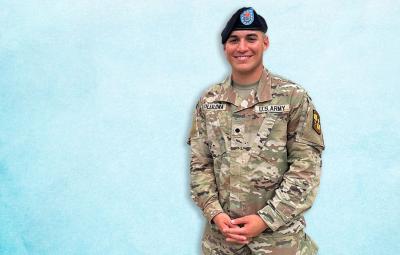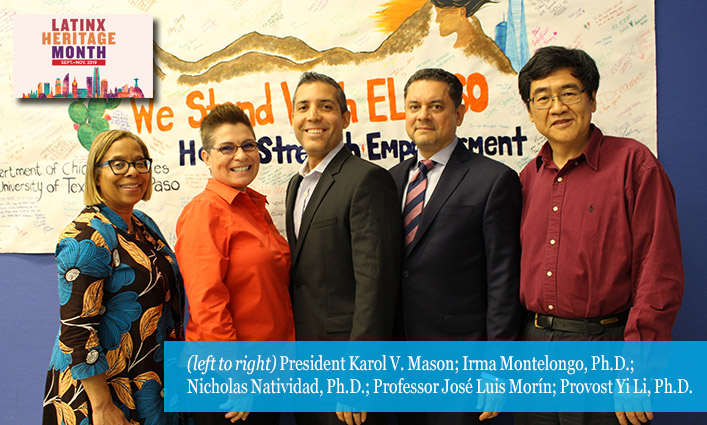
With the goal of educating the John Jay College community on the history of the borderlands and anti-Latinx sentiment in the United States, the Department of Latin American and Latinx Studies (LLS) hosted “El Paso Strong: A History of Resistance, Resilience, and Survival in the Borderlands,” on October 31. The lecture was part of the El Paso Project, an initiative launched by the LLS department following the tragedy in El Paso on August 3. The lecture, given by native El Pasoans and award-winning academic experts, Irma Montelongo, Ph.D., from the University of Texas El Paso (UTEP) and Nicholas D. Natividad, Ph.D, from New Mexico State University (NMSU), explored how the history of hate on the borderlands continues to fuel the Latinx threat narrative today.
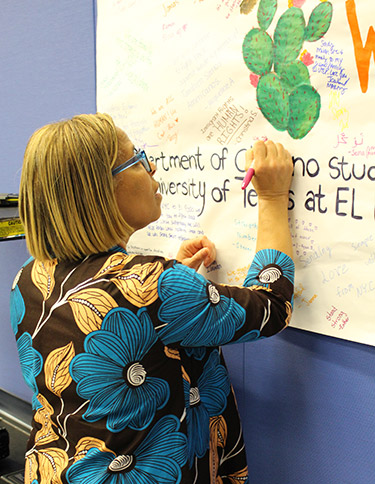
“White supremacy and vitriolic rhetoric has overtaken this country, but anti-Latinx rhetoric has been present, lurking, and festering for centuries in the United States.” —Isabel Martinez
Before introducing the two speakers, Associate Professor Isabel Martinez, Ph.D., a Texas native, spoke of how anti-Latinx sentiment isn’t a new phenomenon in the United States. “White supremacy and vitriolic rhetoric has overtaken this country, but anti-Latinx rhetoric has been present, lurking, and festering for centuries in the United States,” said Martinez, before turning her attention to John Jay’s close ties with El Paso and UTEP. “The LLS department has been fortunate enough to work with today’s speakers, on several projects over the years. First, the global learning communities we created with first-year seminars. And, most recently, on a manuscript focusing on how Latinx Studies at Hispanic-Serving Institutions, like John Jay, can best use technologies to teach and support students,” said Martinez, adding that when she heard of the mass shooting in El Paso, her heart dropped. “The fact that the shooter had intentionally arrived to this peaceful border community to target Latinx folks, Mexican folks, and immigrants—people who look like so many of us here at John Jay—angered me,” said Martinez. “But, it also deepened my resolve that we have to do something to combat hate,” she said, noting that one of the first steps in helping create change is educating oneself and others on the history and impact of anti-Latinx sentiment in the U.S.
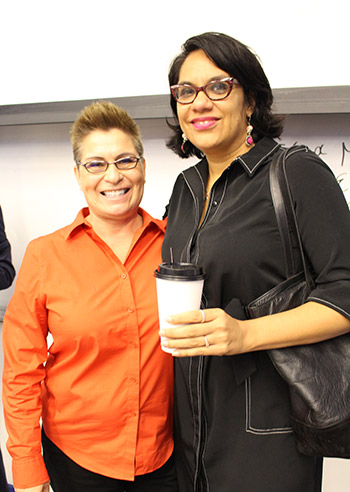
Providing Historical Context
Montelongo and Natividad presented the lecture together, each taking turns to speak on the history of violence and resiliency along the border. “What we want to do is give you historical context of the state of Texas and the city of El Paso so that you all will have a better understanding of how it all ties back to what happened on August 3, 2019,” said Montelongo. Helping to link history with present-day, Montelongo and Natividad broke the lecture down into four categories: the History of Hate; Racial Projects; Racial Scripts; and Rehumanization. And, with each section, they provided specific examples, historical accounts, the media’s portrayal of the Latinx community at the time; and how the struggle continues today. “The history of the borderlands is marked with incredible violence. Between 1848 and 1920 there were at least 571 Mexicans who were lynched in the United States. But these are just documented accounts, the estimated number is believed to be closer to 3,000,” said Natividad, emphasizing his point by showing a quote from the Weekly Arizona Miner in 1873 that referred to Mexicans as “half-civilized, semi-devils.” This dehumanization made it possible for institutional racism to take hold, and for officials to pass laws and policies that obstructed the social and economic mobility of Mexicans and Mexican-Americans in the U.S.
“The history of the borderlands is marked with incredible violence.” —Nicholas Natividad
“It speaks to how the Mexican body is viewed. You have the media and city leaders who support this anti-Mexican rhetoric,” said Montelongo, citing the gasoline baths and the tragedy at Porvenir as prime examples of institutionalized racism’s grip on the borderlands. “After a doctor returned from Mexico, got sick and died, there was an unfounded fear of a Typhus epidemic, so the immigration service and city and county leaders instituted a quarantine and bathing process for all Mexicans crossing the border into El Paso,” explained Montelongo. “If you were Mexican and crossed the border, you were forced to take a bath in a kerosene and gasoline-type mixture. Folks were separated by gender, stripped naked, and bathed in this insidious chemical mixture. Their clothes were washed in these same chemicals, and only then were they allowed to proceed into El Paso.” When a woman by the name of Carmelita Torres refused to go through the bath, she was joined by 30 other women, resulting in what is known as the 1917 Bath Riots. “A year later, in the middle of the night, the Texas Rangers, the U.S. Calvary, and white ranchers went into the mostly Mexican town of Porvenir, Texas, and took 15 boys and men from their homes, marched them to the outskirts of town and massacred them, leaving their bodies behind,” said Montelongo. “The next day, the families found the bodies. They returned home, packed up, and left town because they understood that they would be next. The Texas Rangers came in and razed the town soon after. This is what was transpiring on the U.S.-Mexico border in the early 20th century.”

Creating Racial Projects and Scripts
The anti-Mexican sentiment continued through the Great Depression when over a million Mexicans and Mexican-Americans were repatriated back to Mexico. “President Herbert Hoover came out on the radio and claimed that one of the reasons unemployment was so high was because Mexican workers were taking jobs. Something we hear today,” said Montelongo. These acts of repatriation, would happen several times, over the course of the 1930s, 40s, and 50s. “During World War II, the U.S. and Mexico signed an agreement known as the Bracero Program. The program allowed for Mexican laborers to come work in the U.S. agricultural sector, which at the time was expanding to these corporate farms we see today. But demand was so high that growers began to recruit a large number of undocumented laborers to fill positions,” said Montelongo. “It’s perceived as a crisis, as an invasion and so, once again you have a program created by the U.S. government, called ‘Operation Wetback,’ where over 1.3 million Mexicans and Mexican-Americans are removed from the U.S.”
This notion of “invasion” is still alive today. “The creation of racial identities and the stereotypes attached to them didn’t happen out of nowhere. There were specific racial projects throughout time that created these identities, including the ‘Latinx invasion identity,’” said Natividad, adding that systems of barriers, such as a fence or wall along the border are racial projects that help fuel the narrative. He also noted that having a physical fence or wall at the border is a recent phenomenon, only popping up during the 1970s, 80s, and 90s. “These efforts for systems of barriers are racial projects, and part of this longer historical narrative—slavery, Jim Crow, segregation, and mass incarceration, these are all racial projects, markers in time and in U.S. history that create our notion and understanding of race today,” he said. “At the end it’s about social and political agendas and the resources that are being extracted [from these communities] as a result of these projects.”
“The creation of racial identities and the stereotypes attached to them didn’t happen out of nowhere. There were specific racial projects throughout time that created these identities.” —Nicholas Natividad
With these racial projects come racial scripts that have been developed and moved from one group to another over time. “Think about how Arab-Americans were viewed before and then after 9/11—we already had those racial scripts, we just imposed them on other bodies after the tragedy,” said Montelongo. “The scripts of the Mexican body being diseased and an invading object has now been heaved onto Central American bodies trying to make their way to the U.S.,” said Montelongo. “It’s a different type of migration but it’s the same racial script.” Focusing on the parallels between the anti-Mexican rhetoric of the early 20th century and anti-Latinx sentiment today, Natividad showed the telegram from the 1917 that blamed Mexicans for the perceived Typhus epidemic and headlines from today’s 24-hour news networks and social media announcing diseases at the border. “We’re bombarded with these threatening narratives and these scripts are continuing,” said Natividad.
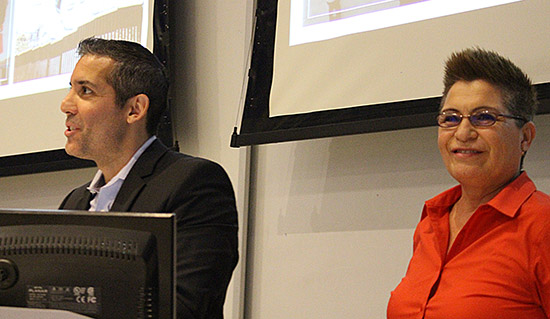
“We live together, we play together, we shop together, we eat together, and we die together, regardless of citizenship or status.” —Irma Montelongo
Rehumanizing and Healing
Acknowledging that the history is long, difficult, and hard to digest, both Montelongo and Natividad expressed that there is still hope, and that hope comes in educating others, speaking up, and showing up. “Resistance, for one, is present along the border,” said Montelongo. She followed that sentiment with visual examples of unity and resistance at the border: a Catholic mass taking place at the border; volleyball being played over the border; and art installations, including a see-saw by architects Ronald Rael and Virginia San Fratello, that allowed kids on both sides of the wall to play with each other. “We live together, we play together, we shop together, we eat together, and we die together, regardless of citizenship or status,” said Montelongo.
With images from El Paso following the tragedy projected on the walls of the lecture hall—candlelight vigils, neighbors embracing each other, and a photo of a widower by his wife’s casket, surrounded by 7,000 people who came to El Paso to support him—Natividad spoke of why he was hopeful. “We all have this struggle within us, this inner war, all these things that have infiltrated us from these racial projects and racial scripts, but we can all transcend these divisions and borders,” he said. “You all represent this border consciousness. You came today to hear this talk about the border, this far-away place. This gathering symbolizes what El Paso is—a community showing up, loving each other—and how it heals itself.”

